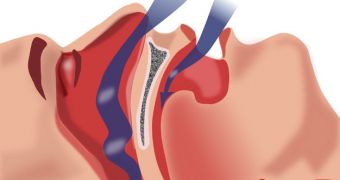In a new scientific investigation, researchers determined that people suffering from obstructive sleep apnea (OSA) exhibit a series of modifications in the structure of their brains that seem to be related to the sleep disorder itself.
Though the team admits that more studies are needed to clearly validate the link, the experts say that OSA indeed appears to be responsible for causing rearrangements in various portions of the brain.
The changes are not without side-effects, they add. People that exhibit the changes may find themselves at increased risks of suffering heart attacks, strokes, excessive sleepiness, as well as generalized cognitive impairment.
OSA is a disorder in which people stop breathing as they sleep, usually for short and frequent intervals. The frequencies of these events (called apneas) dictates the severity of the condition.
It develops because superior airways at the back of the throat tend to collapse in some individuals during sleep, blocking the airways, and stopping air flow to the lungs. The heart and brain are most severely affected by these oxygen deprivation episodes.
The most disturbing thing about OSA is that it's not easily detectable. A person living on their own can carry it for decades without knowing. Most commonly, the disorder is discovered by people's spouses and relatives, which notices the lack of breathing during sleep.
In order to detect the condition, people need to spend a night in sleep laboratories, where experts attach various equipments that monitor breathing during the night. It's only then that a clear diagnostics can be placed, PhysOrg reports.
In past investigations focusing on the effects of sleep apnea on the brain, researchers came up with conflicting results, as they were unable to determine which bran structure modifications caused the cognitive impairment that is a hallmark of OSA.
But the new work, carried by researchers in the United Kingdom and Australia, demonstrated without a doubt that physical differences exist in the brains of apnea sufferers and healthy control subjects.
The team, which published its results in the latest issue of the journal Thorax, say that more work is needed to determine how these changes cause cognitive decline, but say that the link is definitely there.
For the research, the scientists used 60 people. Some of them had OSA, while the others were healthy control subjects. The team then used magnetic resonance imaging (MRI) to keep track of the participants' brain activity.
Conducting research into obstructive sleep apnea is important because the condition affects about 2 to 4 percent of the general adult population. The percentage jumps to 15 percent for seniors, researchers concludse.

 14 DAY TRIAL //
14 DAY TRIAL //